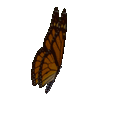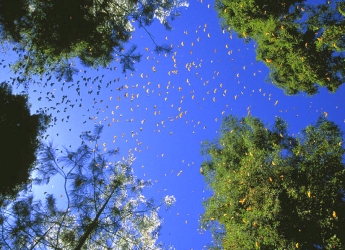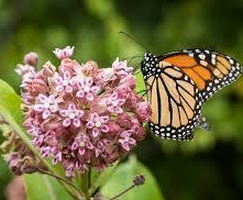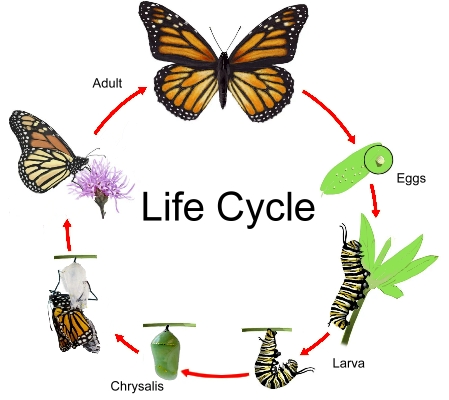

  The Monarch butterfly (order Lepidoptera) is known for its large size, its orange and black wings, and its long annual migrations. Monarchs can be found mostly in North, Central, and South America. The monarch's wingspan averages 9 to 10 centimetres; the colouration of the orange wings, marked by black veins and a black border with two rows of spots, warns predators of the insect's bad taste.
The Monarch butterfly (order Lepidoptera) is known for its large size, its orange and black wings, and its long annual migrations. Monarchs can be found mostly in North, Central, and South America. The monarch's wingspan averages 9 to 10 centimetres; the colouration of the orange wings, marked by black veins and a black border with two rows of spots, warns predators of the insect's bad taste.In North America the Monarch butterfly has an extensive breeding range, and is one of the few butterflies that migrates.  Its annual migration cycle begins in central Mexico, where they head north for the summer, feeding on nectar as they go. Eggs are laid on milkweed plants encountered along the way, and a new generation hatches, matures, and continues the northward trip. Its annual migration cycle begins in central Mexico, where they head north for the summer, feeding on nectar as they go. Eggs are laid on milkweed plants encountered along the way, and a new generation hatches, matures, and continues the northward trip.Monarch butterflies typically live from 2 to 6 weeks, except for the last generation of the year. By the time they reach the northen U.S. and Canada, you're seeing the last of four or five generations that were born and died during the trip north. This last generation, which can live up to 8 to 9 months, makes the entire return journey, as much as 3,200 km, back to Mexico. There they go dormant, clustered by the millions in the branches of trees. During their migration, they can travel as far as 130 km in one day.  The monarch caterpillar is easily recognized by its vertical stripes of black, white, and yellow. Eggs are laid individually on tne Milkweed plant, and the caterpillars feed exclusively on these plants. Milkweeds produce acrid milky juices that contain toxic compounds, which are stored in the caterpillar's body and make the larva and the adult distasteful to predators. After several molts, the caterpillar attains a length of 4.5 cm.
The fully grown caterpillar usually leaves its milkweed plant to pupate elsewhere as a pale green, golden-spotted chrysalis. The monarch caterpillar is easily recognized by its vertical stripes of black, white, and yellow. Eggs are laid individually on tne Milkweed plant, and the caterpillars feed exclusively on these plants. Milkweeds produce acrid milky juices that contain toxic compounds, which are stored in the caterpillar's body and make the larva and the adult distasteful to predators. After several molts, the caterpillar attains a length of 4.5 cm.
The fully grown caterpillar usually leaves its milkweed plant to pupate elsewhere as a pale green, golden-spotted chrysalis. After 10–14 days the chrysalis becomes transparent, and the metamorphosed butterfly’s dark body is visible. The adult emerges upside down and spends several hours drying its wings before being able to fly. Feeding on a variety of nectar sources, adults live only a few weeks—except those that migrate south and overwinter in Mexico, which live seven to nine months. So about four generations of monarchs occur annually.   Climate change threatens to disrupt the monarch butterfly’s annual migration pattern by affecting weather conditions in both wintering grounds and summer breeding grounds. Colder, wetter winters could be lethal, and hotter, drier summers could shift their habitats north. Climate change threatens to disrupt the monarch butterfly’s annual migration pattern by affecting weather conditions in both wintering grounds and summer breeding grounds. Colder, wetter winters could be lethal, and hotter, drier summers could shift their habitats north. In 2013 the number of monarch butterflies wintering in Mexico was at its lowest in 20 years. Abnormal patterns of drought and rainfall in the U.S. and Canada breeding sites may have caused adult butterfly deaths and less plant food for caterpillars. Fewer butterflies up north mean fewer migrate south to Mexico for the winter. |